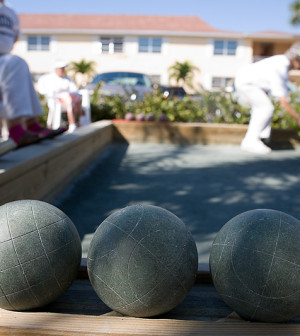- Navigating Your Midlife Crisis: Embracing New Possibilities
- City Raccoons Showing Signs of Domestication
- Mapping the Exposome: Science Broadens Focus to Environmental Disease Triggers
- One Week Less on Social Media Linked to Better Mental Health
- Your Brain Changes in Stages as You Age, Study Finds
- Some Suicide Victims Show No Typical Warning Signs, Study Finds
- ByHeart Formula Faces Lawsuits After Babies Sickened With Botulism
- Switch to Vegan Diet Could Cut Your Greenhouse Gas Emissions in Half
- Regular Bedtime Does Wonders for Blood Pressure
- Dining Alone Could Mean Worse Nutrition for Seniors
Strengthening Hip Muscles May Ease Calf Pain From Blood Vessel Disease


Exercises to strengthen the hips may ease calf pain for people with peripheral artery disease (PAD), a new study suggests.
The disease causes the arteries in the legs and other parts of the body to narrow, restricting blood flow. This can lead to changes in skin color, sores, pain and trouble walking.
Japanese researchers found that people with clogged leg arteries use their calf muscles more while walking since certain muscles in their hips are weaker. By strengthening their hip muscles, they may be able to walk longer without pain, the study showed.
“PAD patients should ask for an expert, such as a physical therapist, to evaluate their gait and the strength of their hip flexors and other muscles. Based on the evaluation, a combination of muscle training and walking exercise may increase how far they can walk and reduce their calf pain during walking,” study author Takaaki Kakihana said in an American Heart Association news release.
Kakihana is a doctoral candidate at Tohoku Graduate School of Medicine in Sendai.
Using a 3-D motion analysis system, the researchers compared the walking patterns of seven healthy people to those of 16 older people with moderate peripheral artery disease. Their average age was 71, and they had some blockage in at least one leg.
The study revealed those with peripheral artery disease had abnormal walking patterns. Specifically, when compared to the healthy participants, those with clogged leg arteries:
- walked more slowly — even when trying to walk quickly,
- took smaller steps at both walking speeds,
- used their hip flexor muscles less when “pushing-off” for each step,
- used their ankle flexor muscles more during the “push-off” for each step.
“Usually older people have relatively weaker ankle flexors and use their hip flexors more during the push-off phase of walking. People with PAD use their ankle flexors more to compensate for hip muscle weakness,” Kakihana said.
During the push-off phase of each step, the ankle flexors and hip flexors serve a different function. Ankle flexors, which are located in the back of the calf, lift the leg with a pushing motion. Hip flexors, on the other hand, are found in the front thigh and lift the leg with a pulling motion.
“It is unclear why the hip flexors are weak in PAD patients. We predict that it is from disuse and blood flow restriction to the muscles,” Kakihana said.
There are certain exercises that can help strengthen the hip flexors, the study’s authors said. They include:
- straight-leg lifts while lying on your back (the other leg is bent with the foot on the floor),
- raising and holding one knee toward your chest while seated,
The findings were to be presented Thursday at an American Heart Association meeting in San Francisco. Findings presented at meetings are generally considered preliminary until published in a peer-reviewed journal.
More information
The U.S. National Institutes of Health provides more information on peripheral artery disease.
Source: HealthDay
Copyright © 2025 HealthDay. All rights reserved.










